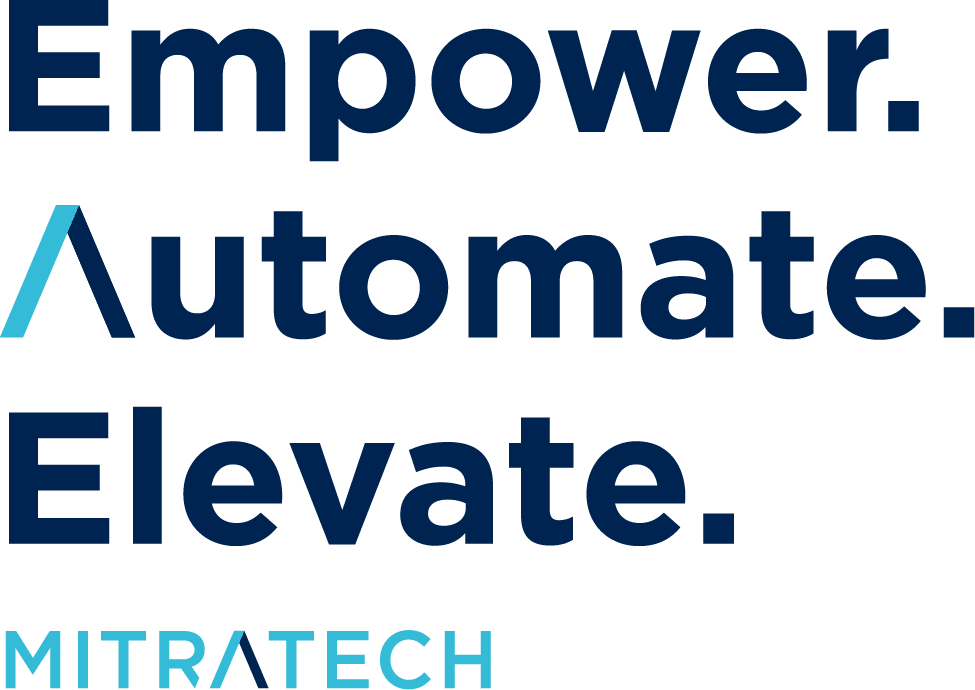Why Outdated Processes Could Be Putting Your Organization at Risk of I-9 Audits
Still relying on outdated I-9 processes? It might be time for a refresh. Staying compliant isn’t just a checkbox, it’s key to passing I-9 audits and protecting your organization from serious risks. Fortunately, there’s electronic I-9 compliance software to help simplify the process, reduce risk, and give you peace of mind that your team is following the I-9 instructions without the manual hassle.
In this blog post, I cover:
- What triggers I-9 audits;
- Common I-9 compliance mistakes to avoid, and;
- How using Form I-9 software (like Mitratech’s Tracker I-9) can save your organization time, money, and headaches.
Let’s dive in!
What’s a Form I-9?
Even for seasoned HR professionals, it’s worth revisiting the fundamentals, especially when it comes to the Form I-9, a deceptively simple document with high-stakes compliance implications.
While completing it is relatively straightforward (it might feel like just another onboarding form), staying compliant long-term is where things can get tricky. Think about managing reverifications for work authorization without missing deadlines, digging through filing cabinets or shared drives to find a form during an audit, or trying to coordinate signatures and ID verification for a remote new hire in another state. These are the everyday realities that turn a simple form into a compliance risk if not handled with precision.
When Is a Form I-9 Filled In?
Form I-9 is a mandatory U.S. form used to verify an employee’s identity and work authorization. Employees complete Section 1 by Day 1. Employers fill Section 2 within three business days.
How Is a Form I-9 Filled?
The Form I-9 can be completed on paper or electronically, and it can be filled out in person or remotely, as long as proper verification procedures are followed. Employees must present valid identity and employment authorization documents, such as a U.S. passport, Permanent Resident Card (Green Card), or Employment Authorization Document (EAD).
Some employers also use E-Verify, a voluntary (unless mandated by state law or federal contract) online system that compares the information from the I-9 to federal databases to confirm work eligibility.
How Long Do You Have to Keep a Form I-9?
Employers are required to retain a Form I-9 for either three years after the date of hire or one year after the employee’s termination, whichever is later.
Why Would an I-9 Get Rejected?
A Form I-9 may be rejected (or considered non-compliant) if the documents provided by the employee do not reasonably appear to be genuine or do not appear to relate to the person presenting them. In such cases, you must not accept the documents for verification purposes.
However, you are required to give the employee a fair opportunity to present alternative documents from the official Lists of Acceptable Documents. As long as the documents are valid and meet the requirements, the Form I-9 can be completed without issue.
It’s important for HR teams to apply this rule consistently and avoid any form of document discrimination. Always focus on whether the documents meet the standards, not on assumptions about the individual.
I-9 Documents List: What Employees Can Provide
To complete Form I-9, employees must present either:
- One document from List A
OR - One document from List B AND one from List C
List A: Documents That Establish Both Identity and Employment Authorization
(Only one document needed from this list)
- U.S. Passport or U.S. Passport Card
- Permanent Resident Card (Green Card)
- Employment Authorization Document (EAD) with photo (Form I-766)
- Foreign passport with a Form I-94 indicating work-authorized nonimmigrant status
- Passport from the Federated States of Micronesia or Republic of the Marshall Islands with Form I-94 (for certain citizens)
List B: Documents That Establish Identity
(Must be presented with a document from List C)
- State-issued driver’s license or ID card with photo
- School ID card with photo
- Voter registration card
- US military card or draft record
- Native American tribal document
- Driver’s license issued by a Canadian government authority
Note: For individuals under 18 without an ID, other documents like a school record or report card may be acceptable.
List C: Documents That Establish Employment Authorization
(Must be presented with a document from List B)
- Social Security card (not labeled “Not Valid for Employment”)
- Birth certificate issued by a U.S. state or territory
- Certification of birth abroad issued by the US Department of State (Form FS-545 or DS-1350)
- Native American tribal document
- U.S. Citizen ID Card (Form I-197)
- Employment authorization document issued by DHS (other than those listed in List A)
Important Reminders for HR
- Documents must be original and unexpired (with few exceptions),
- You cannot specify which documents the employee must present, they choose from the lists.
- Always review documents for authenticity and relation to the person presenting them.
- Store and retain I-9s per federal guidelines.
This information is provided for educational purposes only and shouldn’t be considered legal advice. Employers should stay informed about changes to federal and state employment eligibility laws, as Form I-9 requirements and acceptable documents may be updated periodically by USCIS or other regulatory agencies. Always consult the latest official guidance or legal counsel to ensure compliance.
Here’s more on Form I-9 Accepted Documents from USCIS.
What Triggers I-9 Audits?
The Department of Homeland Security (DHS), through Immigration and Customs Enforcement (ICE), has the authority to conduct I-9 audits to ensure employers are following these requirements.
ICE audits are typically triggered by one or more of the following:
-
Employee or public complaints – Tips about unauthorized workers or improper hiring practices.
-
Data inconsistencies – Mismatches in a Social Security Number (SSN) or anomalies flagged through E-Verify or internal data analysis.
-
Referrals from other government agencies – Information shared by the Department of Labor, IRS, or other federal/state entities during unrelated investigations.
During an audit, the burden is on the employer to demonstrate full compliance. That’s why it’s critical to conduct internal audits regularly and maintain a clean and organized I-9 archive, and why it’s helpful to use technology that ensures forms are complete, timely, and error-free.
How Outdated I-9 Compliance Processes Increase Your Risk of I-9 Audits
Relying on outdated, manual I-9 processes is a compliance risk waiting to happen. It leaves your organization vulnerable to audits, costly penalties, and unnecessary stress. Even more, it can impact your company’s reputation, something no HR team wants on the line for something as avoidable as paperwork errors.
One of the most significant risks associated with obsolete I-9 compliance processes is the lack of accuracy and consistency in verifying employee eligibility. With paper-based systems, making mistakes or overlooking important details is easier, leaving room for errors that can lead to serious consequences.
Furthermore, without electronic I-9 compliance management software in place, keeping track of deadlines and expiration dates can be a daunting task. Missing reverification deadlines can result in non-compliance issues and may even trigger an audit by government agencies.
Another risk lies in the vulnerability of storing physical copies. You know how it is—your desk piles up, your inbox is overflowing, and keeping track of everything becomes a challenge. That’s when paper I-9s start to become a real liability. Physical copies can easily get misplaced, damaged, or buried in the shuffle, making it tough to find what you need in a pinch. And when you’re dealing with stacks of paperwork, keeping it all stored securely isn’t just harder, it’s riskier.

Avoiding Common I-9 Compliance Mistakes: What Every HR Leader Needs to Know
Even for experienced HR professionals, Form I-9 compliance presents unique challenges. With over 1,200 rules governing its proper completion, storage, and verification, the margin for error is small. and the stakes are high. From costly penalties to failed audits, a single oversight can put your organization at risk.
Mismanaging and Misplacing I-9 Forms
One of the most common and costly mistakes is failing to properly manage and retain Form I-9s. As mentioned up top, forms must be completed for every new hire and retained for a specific period, either three years after the date of hire or one year after termination, whichever is later.
Too often, paper forms are misplaced, stored insecurely, or completed incorrectly. In an audit, these gaps can lead to significant fines and reputational damage. To avoid this, many HR teams are transitioning to electronic I-9 systems that streamline storage, track retention timelines, and ensure documents are both accessible and secure.
Navigating 1,200+ I-9 Compliance Rules
The Form I-9 process is governed by a complex framework of over 1,200 rules, covering everything from acceptable documentation to reverification timelines and signature requirements. Missing just one of these regulations, such as an incomplete Section 2 or a missed deadline, can result in fines ranging from $230 to $2,292 per violation.
Worse, repeated errors or knowingly employing unauthorized workers can escalate into more severe penalties and legal consequences.
Avoiding Improper Form I-9 Verification Traps
Maintaining I-9 compliance goes far beyond simply checking boxes during onboarding. It requires clear processes, consistent oversight, and a proactive strategy to avoid costly missteps, especially in today’s complex regulatory environment.
Build Strong Onboarding and Offboarding Procedures
A well-defined new hire and separation process is essential. During onboarding, make sure employees complete Form I-9 accurately and on time, and that your team verifies documents within the required three business days. At separation, have procedures in place to manage retention timelines and securely archive or purge I-9s in accordance with federal requirements.
Know the Risks During Mergers and Acquisitions
M&A activity introduces additional I-9 compliance risks. Whether you choose to retain existing forms or complete new ones, failure to address Form I-9 obligations during a corporate transaction can expose the acquiring organization to audit findings and penalties. Make I-9 due diligence part of your integration checklist.
Avoid Common Verification Errors
Even experienced HR teams can fall into common I-9 traps, such as:
- Accepting invalid or expired documents
- Failing to reverify work authorization for employees with temporary status
- Neglecting to complete or update Section 3 for rehires or name changes
Each of these errors can be flagged during an ICE audit and lead to significant fines, even if they were unintentional.
Streamline Compliance with Electronic I-9 Software
To reduce the risk of human error and simplify compliance, many HR teams are turning to digital solutions. Purpose-built electronic I-9 management system offer:
- Automated reminders for reverifications and retention deadlines
- Remote I-9 completion workflows that support hybrid and distributed teams
- Configurable compliance controls to ensure forms are completed correctly every time
- Secure storage that protects sensitive employee data and simplifies audits
By automating and standardizing your I-9 process, you can ensure greater accuracy, improve audit readiness, and protect your organization from costly compliance failures.

Key Takeaways About I-9 Audits for HR
- Audit readiness starts with accurate, timely, and secure I-9 processes
- Staying compliant with over 1,200 rules requires consistent education and reliable tools
- Regular internal audits and proper retention practices are essential to avoid penalties
- Electronic I-9 management solutions such as Tracker I-9 reduce risk and increase efficiency
Why Partner with Mitratech and Tracker I-9
Mitratech is trusted by thousands of organizations, ranging from Fortune 500 companies to growing mid-sized businesses, for our proven ability to simplify complex compliance processes. With deep expertise in legal, HR, and regulatory technology, we delivers solutions such as Mitratech I-9 Compliance (Tracker I-9) that are purpose-built for accuracy, security, and audit readiness.
Backed by industry-leading support and continuous product innovation since 1987, Mitratech helps HR teams stay ahead of evolving regulations while saving time, reducing risk, and ensuring a seamless employee experience.
The Best I-9 Compliance Software
You don’t have time for clunky, outdated processes, especially when compliance is on the line.
For HR leaders looking to modernize and de-risk their I-9 processes, Mitratech I-9 Compliance (Tracker I-9) offers a purpose-built solution. This end-to-end electronic I-9 compliance platform helps organizations:
-
- Automate I-9 completion and reverification
- Securely store and track form retention
- Flag errors and incomplete sections in real time
- Maintain a fully auditable system of record
By moving away from manual, paper-heavy workflows and embracing a secure, electronic system like Tracker I-9, you not only reduce the risk of costly errors and penalties but also free up time to focus on other SMART goals for HR professionals.
Click the link to request a demo to learn about Mitratech I-9 Compliance and our comprehensive suite of automated HR solutions for compliance and employee lifecycle management.
Our focus? On your success.
Schedule a demo, or learn more about Mitratech’s products, services, and commitment.


